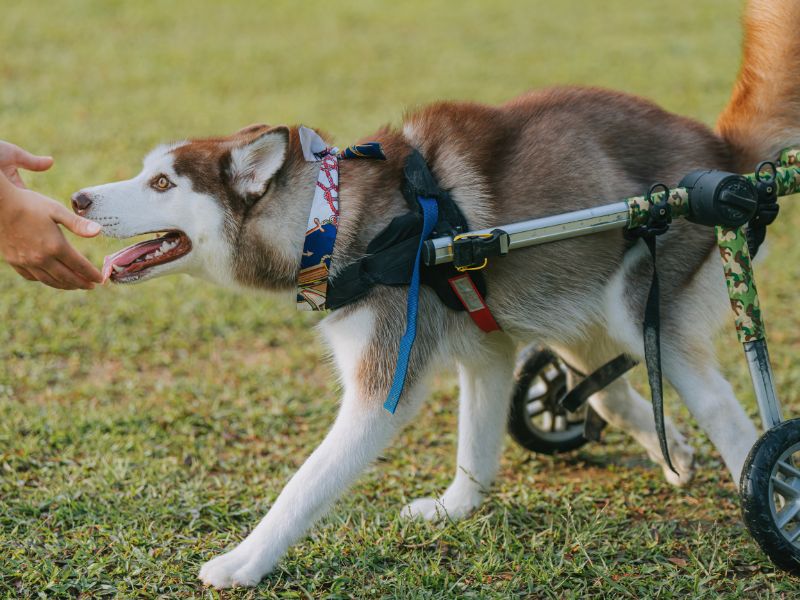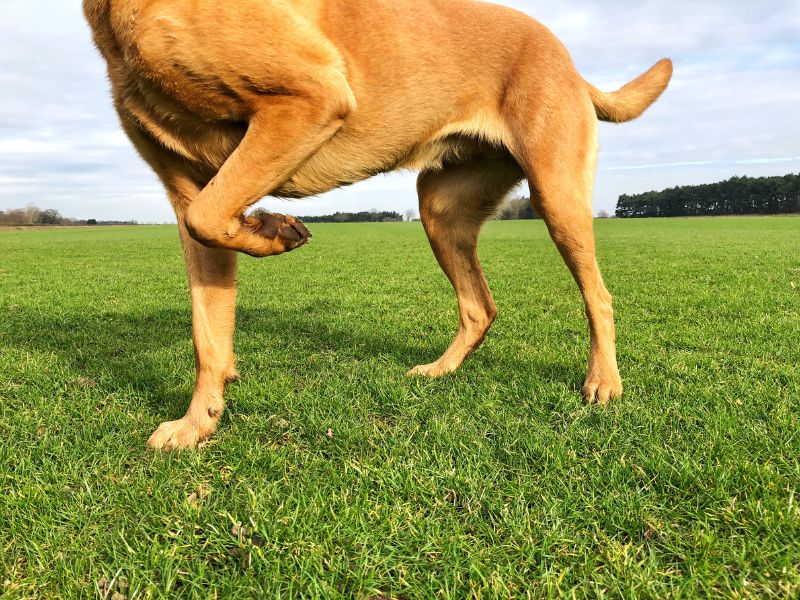Detecting Canine Joint Concerns: The Most Obvious
Our four-legged friends can’t communicate with words, so they often rely on behaviors and subtle cues to tell us when something isn’t right. Just as in humans, dogs can suffer from joint pain. Some of the symptoms of joint pain in dogs are obvious, some not so much. Subtle cues are crucial, but the typical dog parent first sees these symptoms of dog joint pain:
- Limping: Even if it’s intermittent when your dog limps, that is a clear sign of discomfort and may be an early sign of dog joint pain. Even if it’s after a particularly rowdy play time, it’s something to look into further.
- Audible Signs: Your dog might groan or whimper when trying to stand up, lie down, or even while merely stretching. These audible cues can be a direct indication of your dog’s joint pain and something you want to monitor for frequency and severity.
- Swelling or Warmth: Any noticeable swelling around a joint or if the joint feels warm to the touch can be indicative of inflammation or other joint issues.
- Reluctance to Move: A sudden disinterest in walks, playing fetch, or any form of exercise they once loved can be a glaring sign of discomfort. Not to mention, break your heart!
The Silent Symptoms of Joint Issues in Dogs: Why Early Signs Are Often Overlooked
It’s easy to attribute a dog’s decreased enthusiasm for play or reluctance to climb stairs to mere laziness or old age. However, those changes might be your pet’s way of communicating discomfort. While an obvious limp is a clear indicator, it’s also just as important to watch out for:
- Hesitation in Movements: If your dog pauses before jumping onto a bed or hesitates at the bottom of the stairs, it might be an early sign of joint pain. They may become less enthusiastic about playing, walks, or even hesitate to jump onto their favorite sofa spot. Watch out for stiffness, especially after long naps. If your once-patient pet now snaps or growls when touched in certain areas, this could be a sign of pain. Also, observe if they slip more often on tiles or hardwood floors.
- Mood Swings and Appetite Changes: Dogs in pain might show signs of irritability, reduced appetite, or even depression. Your once cheerful pup may now prefer less interaction and even solitude. A dog experiencing joint pain might show signs of appetite depression. They may eat less and appear more lethargic than usual.
- Frequent Licking or Biting: A dog might frequently lick or bite an area where they experience discomfort, and this can be an early indication of joint problems.
- Altered Sleeping Patterns: A dog with joint pain might sleep more than usual or could have disrupted sleep due to discomfort.
- Posture Changes: A slight change in posture, like a hunched back, can be an indicator.
- Difficulty in Certain Positions: Difficulty in lying down or getting up can be early signs of joint issues.
Two Main Types of Joint Pain in Dogs
There are primarily two types of joint problems dogs face – developmental and degenerative. Hip or elbow dysplasia is a classic example of developmental joint issues. Degenerative issues, on the other hand, like osteoarthritis, involve the breakdown of cartilage in the joint. Being able to differentiate between the two is important as they require different approaches to management and care.
- Developmental: Issues present from birth or that develop early.
- Degenerative: Arising from wear and tear or age-related changes. Over time, the cartilage in joints can wear down, leading to conditions like osteoarthritis. Factors such as obesity, age, or even genetic predisposition can contribute to degenerative joint issues in dogs.
Hip or Elbow Dysplasia in Dogs

Hip and elbow dysplasia are genetic conditions where the joints don’t develop correctly. Symptoms can appear in puppies as young as five months old. It can lead to arthritis and pain. Early detection and weight management are crucial. Bernese mountain dogs, among others, are especially prone to this condition.
Osteoarthritis in Dogs
Often referred to as degenerative joint disease, osteoarthritis is characterized by the progressive deterioration of the cartilage that cushions the joints. As the cartilage wears away, bones begin to rub against each other, leading to pain, inflammation, and decreased joint mobility. Several factors can contribute to the onset of osteoarthritis in dogs:
- Age: Just like in humans, as dogs grow older, the wear and tear on their joints can lead to osteoarthritis.
- Genetics: Some breeds are more predisposed to develop this condition than others.
- Obesity: Extra weight puts additional stress on a dog’s joints, accelerating the degenerative process.
- Injuries: Traumas or surgeries can predispose a joint to develop osteoarthritis earlier than it might have otherwise.
Early arthritis signs include:
- Difficulty in standing up after resting
- Reduced enthusiasm for walks
- Stiffness after exercise
- Limping
Ligament Injuries (anterior Cruciate Ligament Rupture) in Dogs
The anterior cruciate ligament (ACL) in dogs stabilizes the knee joint similarly to humans. An injury or rupture to this ligament is one of the most common orthopedic injuries in dogs. It can occur due to sudden movements, like when a dog suddenly turns while running, or due to a traumatic event. Overweight dogs are at a higher risk of ACL injuries because of the added stress on their joints.
Symptoms include acute lameness, swelling in the knee, and pain. Over time, an untreated ACL injury can lead to osteoarthritis in the affected knee.
Infections (lyme Disease)
Lyme disease is a tick-borne bacterial infection caused by the bacterium Borrelia burgdorferi. When an infected tick bites a dog, the bacterium can be transmitted, leading to Lyme disease. One of the primary clinical signs of Lyme disease in dogs is inflammation of the joints, leading to lameness. The lameness can be recurrent and might shift from one leg to another.
Other symptoms can include fever, loss of appetite, reduced energy, and, in severe cases, kidney problems. Early detection and treatment are essential to prevent complications and long-term joint damage.
What Does Current Science Say About the Best Ways to Treat Joint Pain in Dogs?

Current science suggests that treating joint issues in dogs can be approached most effectively through a combination of weight management, diet and nutritional supplements, physical therapy, and lifestyle modifications. Here’s a look at the evidence-based natural treatment options for joint pain in dogs:
Weight Management:
- Why It’s Effective: Excess weight puts added stress on a dog’s joints, exacerbating existing problems and potentially causing new ones. For larger breed dogs, they’ve already got gravity and pressure possibly working against them. Keeping them a healthy weight takes pressure off those joints! Research has shown that weight loss can reduce the need for medications and improve mobility in obese dogs with osteoarthritis.
Diet and Nutritional Supplements:
- Turmeric & Boswellia: Both have anti-inflammatory properties and can help reduce joint pain. Studies have shown that their combined use can effectively manage osteoarthritis in dogs.
- Omega-3 Fatty Acids (from sources like Algal Oil or Green Lipped Mussel): They have anti-inflammatory effects and can benefit dogs with joint pain. A study found that a diet high in omega-3 fatty acids reduced the expression of inflammatory genes in dogs with osteoarthritis.
- Other ingredients: Blueberry powder, green tea extract, and astaxanthin have antioxidant properties, while undenatured type-II collagen has shown potential in reducing pain and improving function in osteoarthritic dogs.
Physical Therapy:
- Why It’s Effective: Physical therapy can improve joint mobility, strengthen muscles, and reduce pain. Hydrotherapy, in particular, has gained attention for its benefits. A study observed that hydrotherapy improved limb function and decreased pain in dogs post-surgery for cranial cruciate ligament rupture
- Lifestyle Modifications: Provide orthopedic beds, non-slip floors, and ramps to reduce joint stress.
- Regular, Gentle Exercise: Regular low-impact exercises like walking or swimming can keep joints mobile and muscles strong without causing undue stress.
Good Gut Health:
- Why It’s Effective: A healthy gut can improve overall health, including joint health. The gut microbiome plays a role in inflammation, and imbalances can contribute to inflammatory conditions. Probiotics, prebiotics, and certain dietary fibers have shown potential in promoting gut health, thereby indirectly supporting joint health.
Gut Health and Its Connection to Joint Health
A healthy gut can prevent inflammation, which is a primary cause of joint pain. The old saying, “You are what you eat,” isn’t limited to humans. The gut plays a pivotal role in overall health, and its balance can significantly impact joint health and joint pain in dogs. But how does the gut play a role in maintaining robust joints?
Good Gut Health Equals Lesser Inflammation: Chronic inflammation, often stemming from the gut, can lead to degenerative joint conditions. Ensuring good gut health can reduce inflammation, decreasing the risk of joint problems. The gut is a significant site of immune activity. When the gut health is compromised, it can lead to an overactive immune response, releasing inflammatory substances into the bloodstream. Chronic inflammation, in turn, can contribute to joint pain and degenerative joint disease. A balanced gut, filled with the right mix of beneficial bacteria, can help moderate this inflammatory response, reducing the potential strain on joints.
Prebiotics, Probiotics, and Joint Health: These are beneficial for the gut and, in turn, support joint health. They maintain a balance of good bacteria in the gut, reducing the chance of inflammation.
Absorption of Nutrients: A healthy gut ensures efficient absorption of nutrients, many of which are essential for joint health, like Omega-3s found in algal oil and anchovy oil. Joint health in dogs, like humans, is highly dependent on things like Omega-3 fatty acids, vitamins, and specific minerals. An unhealthy gut may have compromised absorption capabilities, and that means your dog’s joints may be robbed of these essential nutrients. Ensuring optimal gut health allows for the efficient absorption of these joint-supporting nutrients.
Gut Microbiota and Metabolic Byproducts: The diverse bacterial population in the gut produces various metabolic byproducts from digesting the food your dog consumes. Some of these byproducts, like short-chain fatty acids (SCFAs), possess anti-inflammatory properties. An imbalance in the gut’s microbial composition can reduce the production of these beneficial byproducts, increasing the risk of joint inflammation.
The Leaky Gut Syndrome: An unhealthy gut may lead to a condition known as ‘leaky gut syndrome’ or increased intestinal permeability. This is where the gut lining becomes compromised, and allows toxins and undigested food particles to enter the bloodstream. This can trigger systemic inflammation, including in the joints, potentially causing or exacerbating joint pain.
Gut-Brain Axis and Pain Perception: The gut and the brain communicate closely through the gut-brain axis. Studies suggest that a distressed gut can influence pain perception, potentially amplifying joint discomfort. By maintaining a healthy gut, this over-sensitization to pain can be minimized.
Can Natural Ingredients Help Joint Pain in Dogs?

Understanding the array of natural ingredients that support joint health can make a world of difference! Here are some evidence-based ingredients that can be game-changers in dog joint pain.
- Blueberry Powder & Green Tea Extract: Packed with antioxidants, they reduce oxidative stress, which can lead to degenerative joint disease.
- Turmeric Extract & Boswellia: Both have strong anti-inflammatory properties. They can provide relief from joint pain and help in treating joint pain.
- Yucca Schidigera & Black Pepper Extract: Yucca has traditionally been used for joint health. Black pepper extract enhances the absorption of other ingredients like turmeric.
- Astaxanthin & Type-II Collagen: Astaxanthin is a powerful antioxidant, and collagen supports the cartilage in the joints.
- Green Lipped Mussel & Kelp Powder: These provide essential nutrients that support joint health.
Dog joint pain may be common, but if you know how to detect early signs of joint issues in your dog and work to prevent them and manage them naturally, you can make sure your dog lives its healthiest, happiest life!





